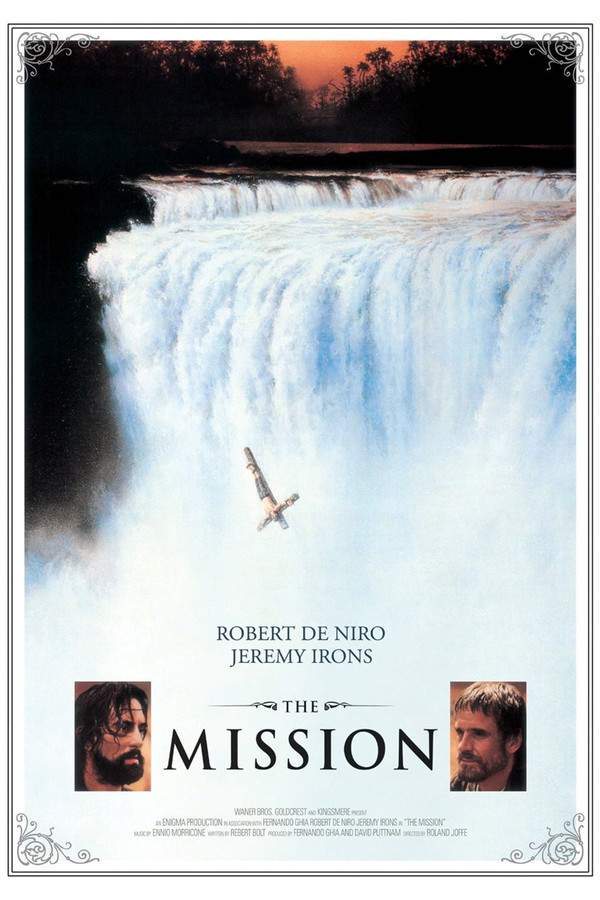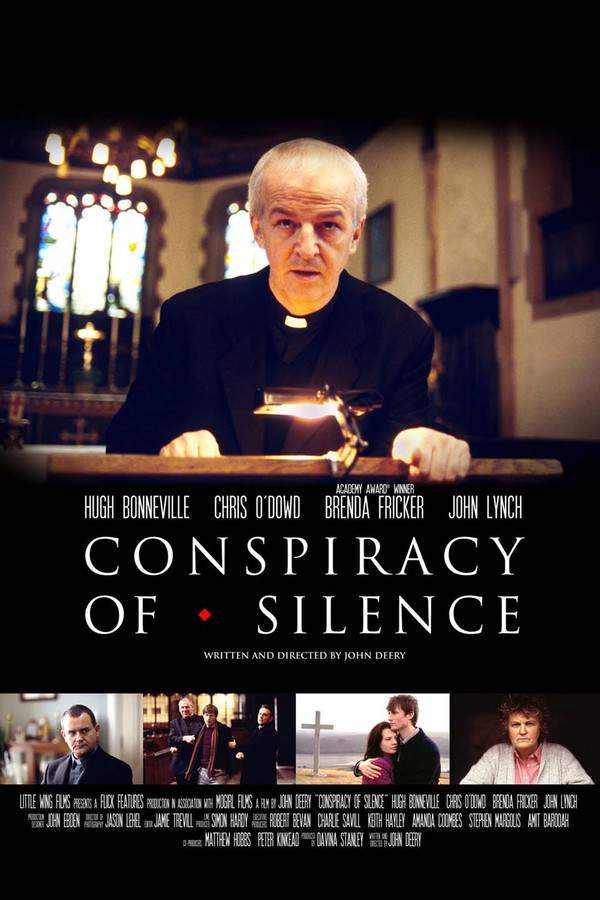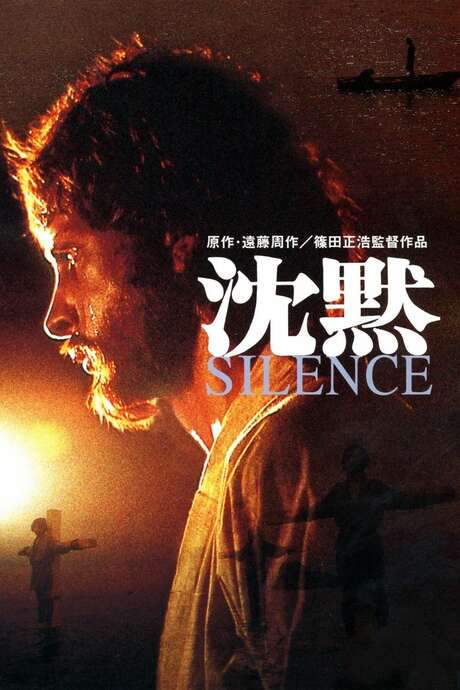
Silence 2016
Directed by

Martin Scorsese
Made by
Paramount Pictures
Test your knowledge of Silence with our quiz!
Silence Plot Summary
Read the complete plot summary and ending explained for Silence (2016). From turning points to emotional moments, uncover what really happened and why it matters.
The film unfolds in 1633, beginning with a chilling prologue where the young Portuguese Jesuit priest, Cristóvão Ferreira, witnesses the horrific torture of Japanese converts he’s been striving to convert to Christianity. Despite his presence, he feels utterly powerless against the Japanese authorities conducting these brutal acts.
As years pass, at St. Paul’s College in Macau, an Italian Jesuit priest, Alessandro Valignano, receives alarming news indicating that Ferreira has renounced his faith (apostasy) under the duress of torture in Japan. His Portuguese pupils, Jesuit priests Sebastião Rodrigues and Francisco Garupe, driven by disbelief and a desire to rescue Ferreira, set off on a perilous journey to uncover the truth. They are joined by Kichijiro, an alcoholic fisherman who fled Japan to save himself, willing to guide them back.
Upon their arrival in Japan, specifically in the village of Tomogi, the priests are disheartened to discover that the local Christian communities have been forced underground. Their shock intensifies when they witness a samurai, referred to as the “Inquisitor,” mercilessly torturing villagers by strapping them to wooden crosses at the ocean’s edge, where rising tides ultimately claim their lives. The subsequent cremation of bodies on a funeral pyre deeply troubles the priests, who recognize it as an act meant to thwart Christian burials.
Believing their presence might trigger further terror from the shogunate, Garupe decides to head to Hirado Island, while Rodrigues ventures to Goto Island—the last known residence of Ferreira—only to find it ravaged and desolate. As Rodrigues roams through Goto, he grapples with a harrowing moral dilemma: whether resisting the demand to recant is egotistical when it could alleviate the suffering of others. His journey leads him to a fateful reunion with Kichijiro, who betrays him to the samurai.
Taken prisoner and transported to Nagasaki, Rodrigues finds himself among many other captured Christians. During a tribunal, he’s informed that Catholic beliefs are categorically opposed in Japan. He insists on meeting Governor Inoue Masashige (Issei Ogata), who unexpectedly turns out to be the elderly man presiding over his case. After being imprisoned again, Kichijiro is brought in and admits that he was coerced into turning him in. He asks Rodrigues for absolution for his betrayal, which Rodrigues reluctantly grants. Upon being instructed to step on a Fumi-e (a crude depiction of a crucifix), symbolizing his rejection of Christianity, Rodrigues abandons his faith to escape further torment.
In a tragic twist, he later observes Garupe and other prisoners being led to the shore, where they are fated to drown unless Garupe renounces his faith. Although still restrained, Rodrigues witnesses Garupe’s unwavering resolve, and tragically, Garupe is drowned while attempting to save another prisoner.
Eventually, Rodrigues meets the older Ferreira, who reveals that he too abandoned his faith under torture, concluding that Christianity in Japan is futile. Rodrigues vehemently rejects Ferreira’s despairing views, yet later, as he hears the agonizing cries of Christians in suffering, an inner voice of Christ compels him to forsake his convictions, leading him to step on the Fumi-e.
Years later, after Ferreira’s death, Kichijiro approaches Rodrigues once more, asking for absolution, yet Rodrigues declines, declaring his withdrawal from the priesthood. Kichijiro, later apprehended with a pouch containing a religious amulet he denies ownership of, disappears, his fate remaining unknown. Ultimately, Rodrigues passes away, and his body is cremated, holding in hand the tiny crucifix given to him upon his arrival in Japan.
Silence Timeline
Follow the complete movie timeline of Silence (2016) with every major event in chronological order. Great for understanding complex plots and story progression.
Prologue: Witnessing Torture
The film begins in 1633 with a chilling prologue where the young Jesuit priest Cristóvão Ferreira witnesses the brutal torture of Japanese converts. Despite his efforts to convert them to Christianity, he feels utterly powerless as the Japanese authorities conduct their horrific acts.
News of Ferreira's Apostasy
Years later at St. Paul's College in Macau, Italian Jesuit Alessandro Valignano receives alarming news about Ferreira's supposed renunciation of faith under torture. This shocking revelation spurs two of his Portuguese pupils, Sebastião Rodrigues and Francisco Garupe, to embark on a daring mission to uncover the truth.
Journey to Japan
Rodrigues and Garupe are joined by Kichijiro, a fugitive fisherman from Japan. Together, they set off on a perilous journey across the sea, driven by disbelief and a desire to rescue Ferreira, unaware of the dangers that await them in Japan.
Arrival at Tomogi
Upon their arrival in the village of Tomogi, the priests are devastated to find that local Christian communities are forced underground. The reality of oppression hits them hard as they witness the merciless torture of villagers by the Inquisitor, leading to emotional turmoil.
Torture and Death
The priests bear witness to an unspeakable scene where villagers are strapped to wooden crosses, drowning as the tides rise. The memory of the subsequent cremation of bodies on a funeral pyre weighs heavily on Rodrigues and Garupe, igniting a sense of urgency in their mission.
Split Paths
Fearing further retribution from the shogunate due to their presence, the priests decide to split up. Garupe heads to Hirado Island, while Rodrigues ventures towards Goto Island, the last known residence of Ferreira, hoping to find answers and possibly rescue him.
Searching Goto Island
Rodrigues searches the ravaged Goto Island, grappling with a moral dilemma about whether resisting the demand to recant is worth the suffering it might cause others. His faith is challenged as he navigates through a landscape of despair and loss.
Betrayal by Kichijiro
During his search, Rodrigues encounters Kichijiro once again, only to be betrayed by him to the samurai. Captured and transported to Nagasaki, he joins other imprisoned Christians, marking a turning point in his harrowing journey.
Tribunal and Meeting with Governor
Rodrigues finds himself in a tribunal, learning that Catholic beliefs are outlawed in Japan. He insists on meeting the Governor Inoue Masashige, who surprises him by presiding over his case, revealing the stark realities of oppression he faces.
The Fumi-e
After being imprisoned again, Kichijiro confesses his betrayal and seeks Rodrigues' absolution. Under immense pressure, Rodrigues is coerced into stepping on a Fumi-e, a symbolic rejection of his faith intended to save him from torture.
Garupe's Last Stand
Rodrigues witnesses Garupe and other prisoners being led to the shore, facing a grim fate unless Garupe renounces his faith. In a final act of courage, Garupe attempts to save another prisoner but tragically drowns, solidifying Rodrigues' despair.
Meeting Ferreira
Rodrigues finally meets Ferreira, who reveals he also abandoned his faith. Ferreira argues that Christianity in Japan is futile, and this meeting forces Rodrigues to confront the meaning of belief and his own survival amidst suffering.
Final Renunciation
Haunted by the cries of suffering Christians, Rodrigues feels an inner voice urging him to forsake his convictions. Ultimately, he steps on the Fumi-e again, symbolizing his complete renunciation of faith in a desperate bid for survival.
Kichijiro's Return
Years after Ferreira's death, Kichijiro returns seeking absolution from Rodrigues. However, Rodrigues declines, having fully withdrawn from the priesthood, embodying his tragic transformation throughout the film.
Rodrigues' Death
In the end, Rodrigues passes away, holding onto the small crucifix given to him when he arrived in Japan. His body is cremated, representing the culmination of his journey with faith, betrayal, and the harsh realities of belief in a foreign land.
Silence Characters
Explore all characters from Silence (2016). Get detailed profiles with their roles, arcs, and key relationships explained.
Cristóvão Ferreira
Cristóvão Ferreira is a Portuguese Jesuit priest who endures heartbreaking torture, leading to his eventual renunciation of faith. His character embodies the conflict between unwavering belief and the desire for self-preservation. Ferreira's transformation influences other priests' perceptions of faith in a land hostile to their beliefs.
Sebastião Rodrigues
Sebastião Rodrigues, portrayed as a devoted Jesuit priest, embarks on a harrowing journey to rescue Ferreira. His strong conviction is tested as he faces moral dilemmas and witnesses the devastating consequences of faith. Rodrigues evolves from a hopeful missionary to a man gravely questioning the utility of faith amidst suffering.
Kichijiro
Kichijiro is an alcoholic fisherman whose complex relationship with the priests highlights themes of loyalty and betrayal. Despite his flaws, he remains a pivotal character that reflects the human struggle for redemption and forgiveness. His actions also serve to challenge the perception of faithfulness amidst betrayal.
Francisco Garupe
Francisco Garupe is another Jesuit priest whose commitment to Christianity stands firmly against the backdrop of persecution. He represents unwavering belief and moral strength but ultimately faces tragic consequences for his convictions. His journey serves as a testament to the perilous nature of faith in an oppressive environment.
Silence Settings
Learn where and when Silence (2016) takes place. Explore the film’s settings, era, and how they shape the narrative.
Time period
1633
The film is set in 1633, a time marked by intense religious persecution in Japan. The Jesuit missionaries faced formidable opposition from the Japanese authorities, leading to the suffering of many Christian converts. This period reflects the broader conflicts between Western missionary efforts and traditional Japanese beliefs, culminating in a struggle for faith and identity.
Location
Japan, St. Paul's College in Macau, Tomogi, Hirado Island, Goto Island, Nagasaki
The movie unfolds primarily in Japan, particularly in coastal regions such as Tomogi, known for its once-thriving Christian community now forced underground. St. Paul's College in Macau serves as the starting point for the Jesuit priests, a significant center for education that highlights the tensions between different faiths. Goto Island represents a desolate landscape, reflecting the despair of lost faith and the plight of Christians persecuted during this era.
Silence Themes
Discover the main themes in Silence (2016). Analyze the deeper meanings, emotional layers, and social commentary behind the film.
🙏
Faith & Betrayal
The movie explores the profound struggles of faith against overwhelming pressure to conform. Characters grapple with their convictions in the face of torture and the consequences of their decisions. Betrayal emerges as a crucial element, illustrated through Kichijiro's actions, questioning the true meaning of loyalty and the complexities of faith.
⚔️
Persecution
Persecution is a central theme, depicted through the brutal treatment of Christians in Japan. The film portrays the harsh realities of faith under duress, revealing the lengths to which individuals will go to uphold or abandon their beliefs. This theme resonates throughout the priests' journey as they witness horrific acts against their fellow Christians.
🌀
Moral Dilemma
Moral dilemmas permeate the narrative as characters confront the painful choices between faith and survival. Rodrigues' internal conflict regarding apostasy highlights the intense psychological struggle faced by those under extreme pressure, emphasizing the weight of conscience in moments of despair.

Coming soon on iOS and Android
The Plot Explained Mobile App
From blockbusters to hidden gems — dive into movie stories anytime, anywhere. Save your favorites, discover plots faster, and never miss a twist again.
Sign up to be the first to know when we launch. Your email stays private — always.
Silence Spoiler-Free Summary
Discover the spoiler-free summary of Silence (2016). Get a concise overview without any spoilers.
In the shadowed streets of 17th‑century Japan, the Tokugawa shogunate has declared Christianity a forbidden faith, driving believers into secrecy and fear. The world is a stark tapestry of disciplined order clashing with whispered devotion, where austere temples loom beside hidden altars and every breath may invite the watchful eyes of the authorities. The film’s tone is meditative and haunting, a slow‑burning portrait of a society that has outlawed hope, leaving the faithful to grapple with silence that feels as oppressive as the regime itself.
Sebastião Rodrigues and Francisco Garupe, two Jesuit missionaries sent from distant lands, arrive in this hostile landscape with a fervent purpose: to tend to a scattered flock of hidden Christians and to gauge the true depth of the persecution they face. Their bond is forged in shared conviction, yet each carries a personal weight—a quiet doubt that questions how a loving God could allow such suffering. Their interactions reveal a delicate dance between steadfast duty and the unsettling possibility that answers may lie beyond conventional faith.
Guided by a reluctant yet resourceful local, Kichijiro, the priests set out on a perilous trek across remote countryside and isolated islands, seeking both the hidden believers and a deeper understanding of the silence that surrounds them. The journey is less about physical distance than about confronting the void within, as the landscape itself becomes a mirror for their inner turmoil. Every shore they approach, every village they glimpse, hints at a larger, unseen struggle that tests the limits of belief and endurance.
Through sweeping vistas and intimate moments, the film weaves a richly textured meditation on doubt, devotion, and the human yearning for divine presence amid oppression. It invites the audience to linger in the unsettling quiet, where the true battle is not against swords or laws, but against the echoing questions that linger in the heart of every faithful soul.
Can’t find your movie? Request a summary here.
Movies with Similar Twists and Themes
Uncover films that echo the narrative beats, emotional arcs, or dramatic twists of the one you're exploring. These recommendations are handpicked based on story depth, thematic resonance, and spoiler-worthy moments — perfect for fans who crave more of the same intrigue.
Featured on this page

What's After the Movie?
Not sure whether to stay after the credits? Find out!
Explore Our Movie Platform
New Movie Releases (2025)
Famous Movie Actors
Top Film Production Studios
Movie Plot Summaries & Endings
Major Movie Awards & Winners
Best Concert Films & Music Documentaries
Movie Collections and Curated Lists
© 2025 What's After the Movie. All rights reserved.









